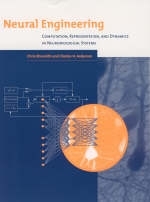
Neural Engineering
Computation, Representation and Dynamics in Neurobiological Systems
Seiten
2002
Bradford Books (Verlag)
978-0-262-05071-5 (ISBN)
Bradford Books (Verlag)
978-0-262-05071-5 (ISBN)
- Titel ist leider vergriffen;
keine Neuauflage - Artikel merken
This study provides a synthesis of the disparate approaches in computational neuroscience, incorporating ideas from neural coding, neural computation, physiology, communications theory, control theory, dynamics, and probability theory.
For years, researchers have used the theoretical tools of engineering to understand neural systems, but much of this work has been conducted in relative isolation. In this text, Chris Eliasmith and Charles Anderson provide a synthesis of the disparate approaches in computational neuroscience, incorporating ideas from neural coding, neural computation, physiology, communications theory, control theory, dynamics, and probability theory. This synthesis, they argue, enables novel theoretical and practical insights into the functioning of neural systems. Such insights are pertinent to experimental and computational neuroscientists and to engineers, physicists, and computer scientists interested in how their quantitative tools relate to the brain. The authors present three principles of neural engineering based on the representation of signals by neural ensembles, transformations of these representations through neuronal coupling weights, and the integration of control theory and neural dynamics. Through detailed examples and in-depth discussion, they make the case that these guiding principles constitute a useful theory for generating large-scale models of neurobiological function.
A software package written in MatLabr for use with their methodology, as well as examples, course notes, exercises, documentation, and other material, are available on the Web.
For years, researchers have used the theoretical tools of engineering to understand neural systems, but much of this work has been conducted in relative isolation. In this text, Chris Eliasmith and Charles Anderson provide a synthesis of the disparate approaches in computational neuroscience, incorporating ideas from neural coding, neural computation, physiology, communications theory, control theory, dynamics, and probability theory. This synthesis, they argue, enables novel theoretical and practical insights into the functioning of neural systems. Such insights are pertinent to experimental and computational neuroscientists and to engineers, physicists, and computer scientists interested in how their quantitative tools relate to the brain. The authors present three principles of neural engineering based on the representation of signals by neural ensembles, transformations of these representations through neuronal coupling weights, and the integration of control theory and neural dynamics. Through detailed examples and in-depth discussion, they make the case that these guiding principles constitute a useful theory for generating large-scale models of neurobiological function.
A software package written in MatLabr for use with their methodology, as well as examples, course notes, exercises, documentation, and other material, are available on the Web.
| Erscheint lt. Verlag | 4.2.2003 |
|---|---|
| Reihe/Serie | Computational Neuroscience |
| Zusatzinfo | 104 |
| Verlagsort | Massachusetts |
| Sprache | englisch |
| Maße | 178 x 229 mm |
| Gewicht | 762 g |
| Themenwelt | Informatik ► Theorie / Studium ► Künstliche Intelligenz / Robotik |
| Medizin / Pharmazie ► Medizinische Fachgebiete ► Neurologie | |
| Naturwissenschaften ► Biologie ► Humanbiologie | |
| Naturwissenschaften ► Biologie ► Zoologie | |
| ISBN-10 | 0-262-05071-4 / 0262050714 |
| ISBN-13 | 978-0-262-05071-5 / 9780262050715 |
| Zustand | Neuware |
| Haben Sie eine Frage zum Produkt? |
Mehr entdecken
aus dem Bereich
aus dem Bereich
Buch | Softcover (2024)
REDLINE (Verlag)
20,00 €
Eine kurze Geschichte der Informationsnetzwerke von der Steinzeit bis …
Buch | Hardcover (2024)
Penguin (Verlag)
28,00 €


